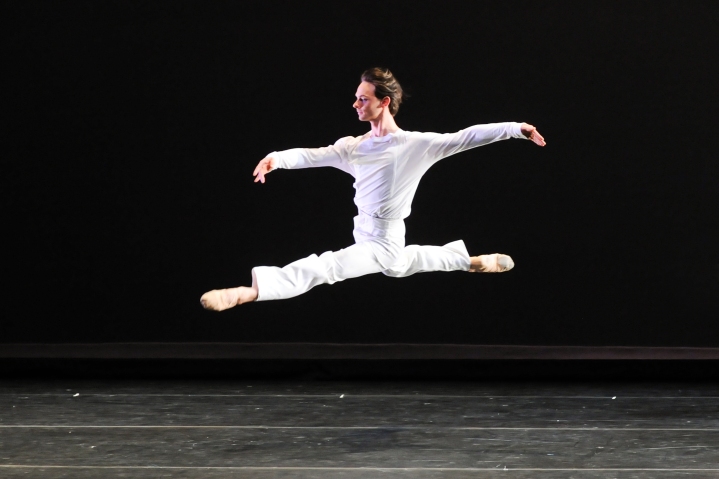
Reviewed by Steve Sucato
March 13, 2013
A year after he co-founded New York’s School of American Ballet in 1934, George Balanchine created “Serenade” (1935), a ballet that began as a lesson for his advanced students at the school on how to perform on a stage. Since then the iconic ballet has become a mainstay in the repertories of professional and pre-professional ballet companies across the globe.
The first of three masterworks by three master choreographers on Pittsburgh Ballet Theatre’s program Unspoken this past Sunday at the August Wilson Center, “Serenade” exemplified the very definition of balletic beauty and grace.
The opening was stunning, the curtain rising on 17 female dancers in long tulle skirts and pointe shoes arranged in two adjoining diamonds, each with one arm outstretched, palm outward. The work offered many elegant movement phrases, some culled from the great story ballets (Giselle,Swan Lake) and some derived from mistakes made during its creation. Through to its striking ending — with dancer Julia Erickson lifted by three male dancers to stand atop one’s shoulders, and be carried slowly toward a mysterious light — “Serenade” mesmerized.

Set to Tchaikovsky’s brilliant Serenade for Strings in C, Op. 48, the ballet is fast-paced and technically unforgiving. For the most part, PBT’s dancers proved more than capable, especially the three female leads: Erickson, Alexandra Kochis and Elysa Hotchkiss. But while the female corps de ballet (which included upper-level students from the PBT’s school) did well forming the ballet’s many lovely lines and dancer groupings, they lacked unison in their dancing into and out of them.
Of note were the performances of Hotchkiss whose fluid movement and gumby-like flexibility gave the sense of her cascading from one graceful phrase into another and the passionate dancing of Erickson.

Antony Tudor’s 1936 classic “Jardin Aux Lilas (Lilac Garden)” followed. It told the story of Caroline (Kochis), a woman betrothed to a man (Robert Moore) she does not love. A moonlit farewell party for the couple in a lilac garden set the scene for a last encounter with the man (Luca Sbrizzi) whom Caroline does love, as well as “an episode” involving a woman (Erickson) from her husband-to-be’s past.
Set to a score by Ernest Chausson and performed masterfully by PBT’s dancers, Tudor’s expressive choreography for the ballet played out like a silent film. Its cast of starched Edwardian-era characters, some sympathetic to Caroline’s plight, streamed on and off the stage through expertly crafted dance phrases adding textural layers to the ballet’s recurrent images of love and longing.
Kochis was endearing as the troubled Caroline, her acting skills along with the ballet’s staging dense with subtle gestures such as her patting her dress and hair to suggest composure and the looks back over the shoulders of the main characters at what might have been were engrossing. So too were the performances of Moore as her stern betrothed, Erickson as the heartbroken “episode” from his past and Sbrizzi.

Whereas “Serenade” was a ballet to move dancers beyond the classroom, the Pittsburgh premiere Mark Morris’ 1988 ballet “Drink to Me Only With Thine Eyes” set to Virgil Thomson’s Etudes for piano, played record-perfect live by pianist Yoland Colin, embraced academic ballet steps.
Morris cleverly twisted those academic steps into a series of spirited ditties that at times had dancers resembling the exaggerated movements of marionettes or had female dancers carted off like upright sleeping statues. The work proved a quirky, satisfying flirtation to conclude PBT’s gem of a program.
Pittsburgh Ballet Theatre’s Unspoken continues 7:30 p.m. March 14, 8 p.m. March 15 & 16 and 2 p.m. March 17, August Wilson Center, 980 Liberty Ave., Downtown, $25.75-68.75, www.pbt.org or (412) 456-6666.
A version of this review first appeared in Pittsburgh City Paper on March 13, 2013. Copyright Steve Sucato.


Steve, wonderful review. I would love to have seen this program. Hope I get to Pittsburgh to see the company. Great blog. ta, Lew
LikeLike